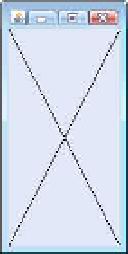Java Reference
In-Depth Information
17
18
application.add(panel);
// add the panel to the frame
application.setSize(
250
,
250
);
// set the size of the frame
application.setVisible(
true
);
// make the frame visible
19
20
21
}
22
}
// end class DrawPanelTest
Fig. 4.19
|
Creating
JFrame
to display
DrawPanel
. (Part 2 of 2.)
Line 6 uses the keyword
extends
to indicate that class
DrawPanel
is an enhanced type
of
JPanel
. The keyword
extends
represents a so-called
inheritance
relationship in which
our new class
DrawPanel
begins with the existing members (data and methods) from class
JPanel
. The class from which
DrawPanel
inherits
,
JPanel
, appears to the right of keyword
extends
. In this inheritance relationship,
JPanel
is called the
superclass
and
DrawPanel
is
called the
subclass
. This results in a
DrawPanel
class that has the attributes (data) and
behaviors (methods) of class
JPanel
as well as the new features we're adding in our
Draw-
Panel
class declaration—specifically, the ability to draw two lines along the diagonals of
the panel. Inheritance is explained in detail in Chapter 9. For now, you should mimic our
DrawPanel
class when creating your own graphics programs.
Method
paintComponent
Every
JPanel
, including our
DrawPanel
, has a
paintComponent
method (lines 9-22),
which the system automatically calls every time it needs to display the
DrawPanel
. Method
paintComponent
must be declared as shown in line 9—otherwise, the system will not call
it. This method is called when a
JPanel
is first displayed on the screen, when it's
covered
then
uncovered
by a window on the screen, and when the window in which it appears is
resized
. Method
paintComponent
requires one argument, a
Graphics
object, that's provid-
ed by the system when it calls
paintComponent
. This
Graphics
object is used to draw lines,
rectangles, ovals and other graphics.
The first statement in every
paintComponent
method you create should always be
super
.paintComponent(g);
which ensures that the panel is properly rendered before we begin drawing on it. Next,
lines 14-15 call methods that class
DrawPanel
inherits from
JPanel
. Because
DrawPanel
extends
JPanel
,
DrawPanel
can use any
public
methods of
JPanel
. Methods
getWidth
and
getHeight
return the
JPanel
's width and height, respectively. Lines 14-15 store these
values in the local variables
width
and
height
. Finally, lines 18 and 21 use the
Graphics
variable
g
to call method
drawLine
to draw the two lines. Method
drawLine
draws a line













